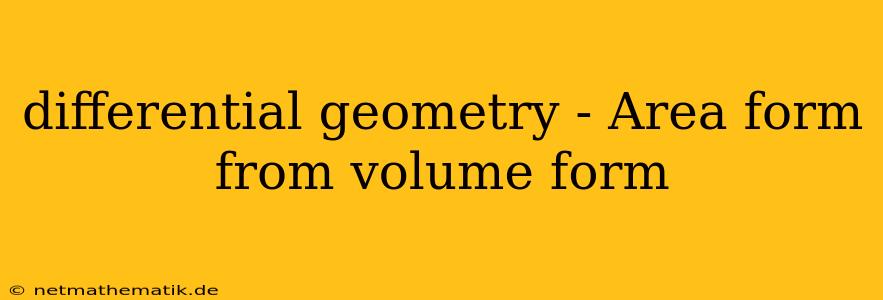Differential geometry delves into the study of smooth manifolds, which are spaces that locally resemble Euclidean space. A fundamental concept in this field is the notion of forms, which are functions that assign a value to each tangent space of a manifold. Volume forms, a specific type of form, are particularly important for understanding the volume of a manifold. An area form, another type of form, is related to the volume form and allows us to compute areas on surfaces embedded in the manifold. This article explores the relationship between volume forms and area forms in differential geometry. We will see how we can derive an area form from a volume form, understanding the connection between these two important concepts.
Volume Forms: Measuring Volume on Manifolds
A volume form is a top-degree differential form on a manifold that allows us to define a notion of volume in the manifold. To grasp this concept, imagine a manifold like a curved surface. A volume form assigns a volume to every infinitesimal region on this surface. In the context of a three-dimensional manifold, a volume form would assign a volume to every tiny volume element within that manifold.
Properties of Volume Forms
Volume forms possess several key properties:
- Non-vanishing: A volume form must never be zero. This ensures that every point in the manifold has a non-zero volume, providing a meaningful measurement.
- Smoothness: The coefficients of a volume form, which are functions on the manifold, must be smooth functions. This ensures that the volume measurement varies smoothly across the manifold.
- Orientation: A volume form defines an orientation on the manifold, meaning it establishes a consistent direction for measuring volume.
Area Forms: Measuring Area on Surfaces
An area form is a differential form of degree two that allows us to measure the area of a surface embedded in a manifold. In essence, an area form assigns an area to every infinitesimal patch of the surface. This concept extends the idea of area from Euclidean geometry to curved surfaces in manifolds.
Properties of Area Forms
Area forms share similarities with volume forms:
- Non-vanishing: An area form must be non-zero to ensure that every point on the surface has a non-zero area.
- Smoothness: The coefficients of an area form are smooth functions on the surface, guaranteeing a smooth variation of area across the surface.
- Orientation: An area form defines an orientation on the surface, indicating a consistent direction for measuring area.
Deriving Area Forms from Volume Forms
The connection between volume forms and area forms lies in the ability to derive an area form from a volume form. This derivation involves restricting the volume form to the surface and then utilizing the geometry of the surface to construct an appropriate area form.
The Process of Derivation
- Restriction: We begin by restricting the volume form to the surface. This means we consider the values of the volume form only on the tangent spaces of the surface.
- Projection: The restricted volume form, while defined on the tangent spaces of the surface, does not directly represent area. We need to project the restricted volume form onto the tangent space of the surface. This involves using the normal vector of the surface to project the volume form onto the plane tangent to the surface.
- Area Form: The result of this projection is a differential form of degree two on the surface, which we can identify as the area form.
Example: Deriving Area Form on a Sphere
Let's illustrate this process with the example of deriving an area form on the unit sphere in three-dimensional Euclidean space.
- Volume Form: The standard volume form in three dimensions is given by $dx \wedge dy \wedge dz$, where $dx$, $dy$, and $dz$ represent the differential forms corresponding to the coordinate axes.
- Restriction: We restrict this volume form to the unit sphere, which can be parameterized using spherical coordinates as follows:
- $x = \sin(\theta) \cos(\phi)$
- $y = \sin(\theta) \sin(\phi)$
- $z = \cos(\theta)$
- $0 \leq \theta \leq \pi$
- $0 \leq \phi \leq 2\pi$
- Projection: To obtain the area form, we need to project the restricted volume form onto the tangent space of the sphere. The normal vector to the sphere at a point $(x, y, z)$ is simply the position vector $(x, y, z)$. Projecting the volume form onto the tangent space using this normal vector yields the following area form:
- $dA = \sin(\theta) d\theta \wedge d\phi$
This area form captures the infinitesimal area of a patch on the unit sphere in terms of the spherical coordinates $\theta$ and $\phi$.
Applications of Area Forms
Area forms have various applications in differential geometry and related fields:
- Surface Area Calculation: The primary application of area forms is to compute the area of surfaces embedded in manifolds. This is achieved by integrating the area form over the surface.
- Gauss-Bonnet Theorem: This fundamental theorem in differential geometry relates the curvature of a surface to its topological properties, and it relies heavily on the notion of area forms.
- Physical Applications: In physics, area forms are essential in describing phenomena related to surfaces, such as the flux of a vector field through a surface or the calculation of the surface tension of a liquid.
Conclusion
The relationship between volume forms and area forms is a crucial aspect of differential geometry. The ability to derive an area form from a volume form allows us to measure area on surfaces embedded in manifolds. This concept has widespread applications in geometry, topology, and physics, illustrating the fundamental importance of these forms in understanding the geometric properties of spaces.
